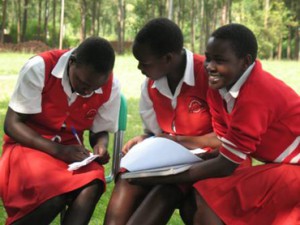
Although their cultures differed greatly in most aspects, the pre-colonial Uganda societies shared a common education system. Prior to the coming of Christian missionaries, there existed no schools of the type that we have today. Nonetheless, people were educated and trained. There existed what the Europeans described as informal education. There were no defined institutions of learning, no particular teachers, no blackboards or pencils and books, but children could be taught all the same. In all the societies, the system of instruction tended to be similar; only the subject matter or syllabus differed according t the particular needs and social values of the given society.
The traditional educational system was designed to create an ideal individual who would fully fit into and be accepted by society. Accordingly, discipline and respect were emphasized. The instruction normally took place round the fireplace after the evening meal or whenever a child committed an offence. Through stories, tales and riddles, the mother or grand mother would alert the children to what society expected of them as they grew up. The fathers would, through proverbs, stories and direct instruction, teach the young boys their expected roles in society. Some societies used capital punishments t alert the young generations to the gravity of particular cases of indiscipline and immorality. The Bakiga, for instance, would end the life of a pregnant girl by trying and throwing her down a steep cliff in order to teach those who contemplated having sex before marriage that the consequences were bitter. As for Banyankole, they would curse and disown the girl who became pregnant for reasons similar to those of Bakiga. The Langi and the Acholi would fine the boy heavily for such misconduct. This would help persuade the young that such an act was social undesirable.
If for example a man was caught committing adultery with another man’s wife among the Kakwa, the Alur, the Lugbara, the Langi, the Iteso and the Acholi he would be killed by the offended party and there would be no case to answer. Among the Karimojong, the offended man would confiscate all the cattle of the offender and he would continue to confiscate every thing the offender would come to possess until such a time as sufficient as sufficient honour had been restored to the offended. Some other punitive measures were taken to curb indiscipline and dishonesty in society. The punishments varied according to the weight of the offence as it was viewed by a given society. Most societies decried stealing and sorcery and in an attempt to educate the young not to indulge in such activities, the thieves and the sorcerers were either chased away from the village or even killed.
Education was not only confined to discipline. It was an all round process which catered for all facets of the individual. Apart form morals, it also catered for the mind and the hand. There was nothing like irrelevant education. All that was taught was geared towards the creation of an ideal individual who would ably fit into the society in which he was born and lived. In order to encourage togetherness and co-operation, the history of the society was often recounted. Among the Kakwa, the Baganda and the Banyoro, there were special persons with the duty of recounting the history of those societies. The people were taught about their origins, their relations with their neighbors as well as the common instances of rejoicing and suffering. The main purpose in this recounting of the people’s historical and social traditions was to enable the society to restrain a common heritage and identity.
It was imperative that the young be taught their cultural values, norms, taboos and totems. The young were taught the do’s and don’ts of the society into which they were born. They were taught about their clans and the totems and the taboos of those clans. Besides, they were they were also taught about their clan relations and their boundaries in order to avoid incest. The boys were taught and trained to grow up into responsible men in much the same way as the girls were groomed t grow up in responsible housewives. The boys among the Bakonjo, Bamba, Bagishu and also girls among the Sabiny were initiated into manhood by under going the ritual of circumcision. Accordingly, the fathers would train the boys in methods of herding, fighting, hunting, agriculture and trade. And the mothers would instruct the young girls in the proper ways of cooking, basketry, pottery, childcare, dressing and other functions related to house keeping.
As for the technical skills, there what is generally referred to as learning-by-doing. Boys would acquire skills while working alongside their fathers just as girls would duly acquire skills while working alongside their mothers. If one’s father was a blacksmith, his son would learn the art by working with him. This helps to explain why some skills like ironworking, rainmaking, divination, healing, pottery and several other specialties tended to be hereditary. As a result, one finds that the Okebu wee renowned iron-workers, the Banabuddu of Buganda were barkcloth makers, the Banyoro were good red-spear makers (emitiri) etc. These skills were not found generally within each society but they were particular t individual clans within the given society.
In general terms, therefore, if one wants a striking example of education for descent living, pre-colonial Uganda provided it. Those who mastered the skills in their respective fields were held in high esteem. The diviner and healer in Bugishu occupied high places. The Etogo or Ateker was as much a legislative body as the parliament of today. An expert fighter or dancer was well qualified.
The whole system of educating and training the young generations in the Ugandan societies was discouraged by colonialism. The Christian missionaries who arrived in Uganda in 1877(the CMS), 1879 (the white fathers), 1896 (the Mill Hill fathers) and 1910 (the Verona fathers) started conducting formal education. They were joined in their efforts by the colonial government after 1920. With the arrival of missionaries and the establishment of mission schools, the education system changed. Emphasis was firs t placed on the 3R’s (writing, reading and religion). Later, the emphasis shifted t liberal arts. At present it is on sciences, at least in theory.
Cultural transformation
With advent of foreign religious and colonialism in the second half of the 19th and early part of 20th century, the traditional cultural set-up of different Ugandan societies was transformed. The whole outcome was a qausi-colonial culture which tended to describe every thing African as “[black” causing the people to discard their cultural values and imitate Europeans in manners of worship, marriage, eating, eating, walking, dressing and even talking.
The first Arab caravan trader reached Buganda in the 1840’s. He was called Ahmed Bin Ibraihim. Although he was much more interested in trade than any thing else, he also talked about Allah. By 1869, Kabaka Mutesa I of Buganda had already joined the other faithful in the Middle East and other parts of the muslin world t observe the month of Ramadan. BY 1876, Islam had taken a firm root in Buganda. The other two religions of the Christian faith followed in1877 and 1879 and by`894, Uganda was declared a British protectorate. Henceforth, colonialism and religion worked hand ion hand to transform the various societies of Uganda into the state they are today.
Religion and education brought about change. Prior to the intrusion of foreign religions, Ugandan societies had their own ideas of God. When Muslims and later the Christians came in, they described the African ideas of God as being erroneous and evil. Accordingly, they started searching around for traditional names to represent their God. The Muslims had little difficulty in getting a name. Their God was Allah and Allah he would remain. The Christians however needed an interpretation. In most cases, despite their misgivings, they ended up using the traditional equivalents to describe their big God; one funny instance was among the Acholi, Langi, Alur and Lugbara. Their traditional idea of God was Jok but the Europeans associated Jok with evil and so they forced the people to use Lubanga for God while Lubanga in Lwo language means evil spirit.
With the introduction of Islam and Christianity, it became fashionable to communicate with God in Arabic, Latin and English. The mode of worship changed greatly as the traditional shrines of abila type were replaced with mosques and churches with seats, church organs and electricity. Prayers became regular on every Friday for Muslims; and Sunday for Christians or in the evenings. Praying no longer depended on particular instances of want or trouble.
Gradually religion did not only become a belief but also a way of life. Accordingly, the eating habits and manners of dress came to be styled according to religions. The Muslims took up the Arab style while the Christians took up the European style. The African values were severely undermined by the new foreign religions and European colonialism to the extent that those who became greatly engrossed in religion and education came to despise the traditional ways of life.
The foods and eating habits have also changed. The Muslims would prefer rice and they do not eat pork and unhallowed meat. Some Christians would neither eat pork nor drink alcohol because the Israelites upon whom the holy bible is based where told not to do so by God. It is now fashionable for families to together on the table with forks, knives and spoons rather than sitting down. Middle –class families will be seen taking mid-morning tea with bread, butter and jam. The national days of rejoicing have been changed and the modern disc and tape recordings take precedence over the traditional songs and dances.
The traditional cultural set-up has been transformed so much that some people seem to wish themselves changed to look white or yellow. The women have been the most affected in this respect. In fact some women would love to have their bodies resemble those of the Europeans and they would rather curl their hair or have it other wise treated since wigs have become unfashionable.
Although generally speaking there has been a high degree of cultural transformation, some of the Ugandan societies have retained their significant elements of their culture. Thus though most people have adopted what they call the modern culture, their tradition and cultural traits can still be traced.
For example the modern dress of the Baganda which could be said to be traditional, is the Kanzu for he men and Busuuti fir the women. For the Banyankole, it is also the gomesi for the women while the men would not mind a suit in the form of a pair of trousers, a shirt, a coat and preferably also a hat. The Bakiga men prefer to dress like Banyankole in the manner described previously. The women seem comfortable in the Kiteteya with a small suuka flung over the shoulders. These changes have no t been confined to the particular societies mentioned above but they have extended with slight variations to cover al the other societies of Uganda. In fact due to religious influences, most people in Uganda have an Arab or European name besides their own traditional name.
In terms of political set-up, Uganda is now a republic. Her economy is partly integrated in to the world capitalist system. It produces coffee, cotton, tobacco, tea, maize, rice and groundnuts for sale to other countries. In the rural areas, the traditional foods are still cultivated but in addiction, cash crops are also grown. To say the least, the traditional system has been greatly transformed. In most of the Uganda societies a new culture had replaced the traditional culture.

 Posted in
Posted in 

